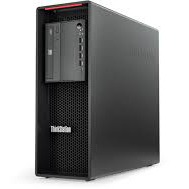It’s time to crack open a can of beef jerky, shutter the windows, and snuggle up with a tower workstation again. That’s not weird at all because this workstation happens to be a Lenovo ThinkStation P520. Yes, quell your exuberance. As you may know, the P Series is Lenovo’s top o’ the line PC family for professionals in engineering, automotive, media, and other graphically-demanding, performance-pushing industries. It’s considered mid-range by those who get their kicks by categorizing computers, so we wanted to see what we could throw at it. Lenovo was kind enough to send over the P520 to carry out some Quadro RTX 4000 tests we’ll have in an upcoming article. Until then, let’s have a look at what this puppy can do.
OVERVIEW
The Lenovo ThinkStation P520 Workstation sits smack-dab in the middle of Lenovo’s P Series Tower family flanked on one side by its compact twin, the P520c, and the entry-level P330 Tower Workstation and on the other side by the high-end P720 and P920 Tower Workstations. Though the entire P Series provides M.2 storage and NVIDIA RTX GPU options, the 520 slips you into 256GB+ Memory range and Intel Xeon W Series processing power.

The base configuration starts at $1200 but you can pop that price above $10k with all the bells and whistles. If you just want a little more GPU power (like I did) and go with an NVIDIA RTX 4000 GPU to the base configuration, the price comes in at $1900. And let me say, totally worth it to go from the Pascal to Turing microarchitecture that adds the AI Tensor Cores and RT Cores for dedicated real-time ray tracing.
What’s in the Box?
The ThinkStation P520 setup here includes an Intel Xeon W-2133 (3.60 GHz, 6 Cores, 8.25MB Cache) processor with 16 GB RAM, a 500GB Samsung SSD, and is running Windows 10 Pro. It also sports the Side panel Lock Kit option and DVD Burner/CD-RW Optical Drive. Front ports include 4x USB 3.1, 15-in-1 Card Reader, and Mic/Headphone jack. Rear ports include 4x USB 3.1, 2x USB 2.0, 2x PS/2, 1x Thunderbolt, 1x GB Ethernet, 1x Line-in, 1x Line-out, 1x Mic. Altogether, this setup, as configured on lenovo.com, comes in at $2524 (after automatic discount).
The only difference I’d make to this configuration is opting for a primary 1TB M.2 SSD, switching the Quadro P4000 for a Quadro RTX 4000 and adding Wi-Fi (I move my rig around and like the redundancy). This puts the price at $3134 (after automatic discount).
Lenovo ThinkStation P520 Specs
On specs alone, the ThinkStation P520 Workstation bumps you up to the sub-$2k+ range and easily within the $2k range depending on features you need with options that bring more speed, storage, and gigabytes. The table below breaks down the max available features. You can view additional specs here.
| Category | Spec |
|---|---|
| Size | 18.0 inches x 6.5 inches x 17.3 inches (455 mm x 165 mm x 440 mm) |
| OS | Windows 10 Pro (64-bit) |
| Processor | Intel® Xeon™ W-Series (up to 4.5 GHz, 11MB cache, and 18 cores/36 threads) |
| RAM | Up to 256 GB DDR4 (2666 MHz) |
| Storage | Up to 8x drives/4 internal (Max: 3.5″=36TB, 2.5″ SSD=12TB, M.2=2TB); RAID 0, 1, 5, 10 |
| Graphics | Up to 2x NVIDIA Quadro RTX |
| Port options | Front: 4x USB 3.1 (Gen 1), 1x Thunderbolt 3 (Type C), Mic/Headphone Back: 4x USD 3.1 (Gen2), 2x USB 2.0, @x PS/2, 1x Thunderbolt Adapter, 1x GB Ethernet, 1x Audio Line-in, Line-out, Mic, 1x eSATA, 1x Firewire |
| Wireless | Intel Dual Band Wireless 802.11ac + Bluetooth |
| Power Supply | 690W 92% efficient, 900W 92% efficient |
| Price | Starting at $1,200.00 Lenovo | Amazon |

HIGHLIGHTS
The Design
There’s a lot to love about the design of Lenovo tower workstations. For a black box you spend so much time with, you want it to have the functional form you would expect from your best tool. Lenovo delivers this in spades for the P520 from ample up-front port to extra rear ports and all an unassuming honeycomb front face that allows plenty of airflow. The signature Lenovo-red touchpoints make grabbin, unlatchin’, pressin’, and flippin’ easy.
The Storage
The P520 is the first tower I’ve used that has more internal storage options than external drives I’ve traditionally used, and it’s the first tower I’ve used with an M.2 option. As mentioned, I’d choose that as the primary with the existing 512GB SSD as backup. Most of my data is on external drives though (mainly from switching computers so often) so I wouldn’t max out on internal storage, but nice to know I can expand if needed.
The Ports
It almost seems like there can never be enough USB port options. This is the first computer where I’ve been able to use all ports without resorting to expansion, adpaters or monitor ports. The Thunderbolt (USB-C) is a welcome addition as well.
The Upgrades
You may not switch out components or add upgrades very often, but this is one area where Lenovo ThinkStations shine. Internal access through the side panel (with lock kit option) is simple with a large schematic on the panel that identifies the location of each component and slot, along with memory and M.2 installation guide. With this info and the red line/arrow touchpoints, replacing or adding components is straightforward if you’ve never done it before and even easier if you have. To see an example, check out our article on swapping an NVIDIA GPU in a Lenovo Workstation.
The Quiet
What I appreciate most about the P520 (and the P-Series options I’ve used) is how quiet this machine is. There are three Delta Electronics Brushless fans in this rig (front, back, and on the CPU). I expected it to run hot when cranking the CPU, but had the cores averaging 71 degrees at 100% CPU usage, with the fans never ramping up to compensate, and only warmish air out the rear fine over a 90 minute render operation. I was not expecting that at all.

CONCLUSION
With the options for tower workstations, the options within the Lenovo P-Series, and the options within the P520 ThinkStation itself, there’s no lack of finding a balance on price and performance. For my needs, I budget $2k-$3k every two years for a workstation. Though the base configuration is underpowered for my needs, the ability to upgrade graphics and storage is simple and leaves me room for more. With those options added, the P520 sits right inside the $2k-$3k range but, compared to other towers I’ve used in the past, it feels like using a computer that costs a few grand more.
The P520 options bring the combined power of Intel Xeon CPU processing and NVIDIA RTX GPU graphics that really deliver a high-end experience in a mid-range package. Along with ample ports, and ample space for upgrades and maintenance, you get a machine that can serve your current needs and expand on storage, memory, or GPU should you need it. Most surprising of all, it’s a system that performs exceptionally while sitting quietly beside your desk with not so much as a purr. All this adds up to a tower workstation I would want on design projects and one I would definitely have on the shortlist for workstation upgrades.
Lenovo ThinkStation P520
Price: Starting at $1,214.00 Lenovo | Amazon
More information: Lenovo ThinkStation P520

![Lenovo ThinkStation P520 Workstation [Review] Lenovo ThinkStation P520 Workstation Review](https://www.solidsmack.com/wp-content/uploads/2020/03/lenovo-p520-thinkstation-workstation-07a.jpg)





